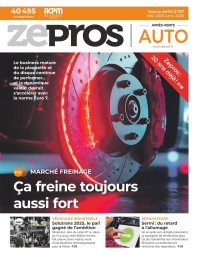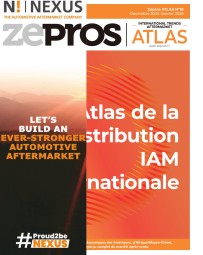
Bosch : “Independent workshops’ access to the technological system is the crux of the matter”

At the heart of a storm shaking OE suppliers, Gaël Navinel, Vice-President Automotive Aftermarket Sales Europe West at Bosch, delivers a calm but straightforward vision of the global parts market and the German group's strategies to resist!
Can you first share Bosch’s 2023 results with us?
Gaël Navinel: Sales across all activities in 2023 came to €91.6bn (+3%), of which €56.2bn (+7%) for the automotive sector, renamed ‘Mobility Solutions’, representing 61% of the Group's total sales, with 237,100 employees.
By region, owing to our European base, sales in Europe rose by 6% to €46.8bn. Asia-Pacific is our second largest market, with sales of €27.9 billion, up only slightly (+1%) due to the slowdown in the Chinese market. The Americas follow with €16.9 billion. The geopolitical context is a major factor in the results of an international group, whether in the automotive or construction sectors, which together account for around 80% of our total sales. Proactive political decisions connected with the ecological transition in certain countries, particularly in Europe, often have an effect on these two markets, which are vital to the economies of many countries.
What are the most buoyant markets for you?
G.N.: North America was very dynamic in 2023, but has been slower in 2024, aided by an economy riding a wave, itself driven by billions of dollars injected via the Inflation Reduction Act after Covid-19. This dynamism has attracted growth-generating investment. The gap between Europe and the United States over the last fifteen years is flagrant - and is even getting wider! Looking over the long term, Asia is also booming, but this is mainly due to China. And when the Chinese economy seizes up, many countries suffer. On the other hand, we still have a relatively small presence in Africa, outside the Middle East.
Would you say that OE suppliers are suffering a scissor effect?
G.N.: Absolutely. The sector is in a phase where massive investment is needed more than ever before in so many technologies at the same time. Several billion euros are being spent on electrification, hydrogen, driving assistance, semi-conductors, software, etc. All of which means deploying substantial resources here and now, but with a long-term return on investment. All this at a time when original equipment volumes have fallen significantly. This is a very challenging environment for equipment manufacturers, some of whom are heavily in debt, which is not the case for us. Bosch's good fortune is that it is not listed on the stock exchange, which gives us greater flexibility and a longer-term horizon than just quarterly publications! I would add that, even if we can talk about a strained context, the OE landscape has been constantly reshaping itself over the last twenty years. Concentration has been underway for a long time now, through portfolio rationalisation, mergers and acquisitions.
Are all suppliers putting the brakes on?
G.N.: No, not all of them. At Bosch, we are not cutting our investments, and we are not losing momentum. On the other hand, the situation is forcing us to be ultra-economical on costs and even more selective on investments. We may have to make adjustments, because it is vital to focus on the most judicious and strategic investments over the medium and long term. When a subject is identified as such, we commit the necessary resources, whatever the sector. We know that technologies are going to evolve, so we analyse the added value created, the competitive position achieved, the synergies with our existing businesses and the profitability that can be generated. We did this last summer, for example, when we bought Hitachi/Johnson Controls' HVAC (Heating Ventilation, Air Conditioning) business for €8 billion. In the automotive sector, we are also investing in temperature management and air conditioning... The strategy is the same with electrification. When we have to divest, it's because we want to grow strategically in our core business. But to do that, we need to find the resources to do so, without recourse to the stock market and in addition to bank loans. It is another way of investing when we clean out activities that are no longer strategic from our portfolio. This does not mean that the activities we sell are not profitable. Generally speaking, we consider that a business is less strategic if we cannot be among the top 3 in the world.
What are the big challenges in the global aftermarket?
G.N.: There's a lot of talk about electrification; I think we need to include softwarisation, which is less visible but potentially more structural! It's a major challenge, because it's already present on a massive scale, whatever the type of vehicle engine. It's a major cross-industry issue, from original equipment to workshops. It is this technological trend in particular that led us to reorganise our ‘mobility’ business, with 250,000 people assigned to it in 2024. No other technological trend has led us to reorganise on this scale. We used to have several divisions (diesel, petrol, braking, electronics, multimedia, etc.) and each worked on functions in silos. We used to sell separate ECU, braking, engine management and battery management solutions, and one day Tesla completely changed all that, followed by the other manufacturers, with a central computer controlling the entire vehicle. It's a way of working that completely upends the value chain and its players. Everything works transversally between the different functions of the vehicle.
What are the consequences for workshops?
G.N.: They have to be able to communicate with these mainframe computers, otherwise they can't work on the vehicles, or they can only do so to a limited extent and waste a lot of time. We are the first to be able to access all the functions of Tesla's on-board computer with our diagnostic tool, so that we can carry out work on all the vehicle's functions. This calls for substantial investment. The technician can log in to the vehicle and work with our ESI[tronic] Evolution software. Our aim is to authorise and simplify all access to manufacturers' portals. We have standardised connections with our Secure Diagnostic Access (twenty-seven brands covered). It's a real added value, saving time and money for the garage owner. We can help them by connecting remotely, with Remote Diagnostic, and doing the work for them. We are also going to launch a vehicle state of health certificate, which will enable us to tap into new customer segments. The crux of the matter today is independent workshops' access to the vehicle's technological system. European laws such as the Data Act, just like everywhere else, will further clear things up. And there's nothing to say that tomorrow's independent aftermarket won't be offering solutions that guide customers directly to their workshops.
Key figures
• €91.6 bn sales in 2023 (+ 3 %) and €4.8 bn operating profit (EBIT), a 5 % margin. Sales breakdown:
• €56.2 bn in Mobility solutions (+ 7 %),
• €7.5 bn (-2%) in Industrial Technology
• €19.9 bn (- 6 %) in consumer goods
• € 8 bn (+ 8 %) for the Energy and Building Technology division
• 429,400 employees, including 90100 in R&D.
• €7.3 bn investment in R&D (8 % of sales)








